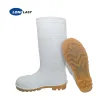Working in the food industry demands specific considerations when it comes to choosing the right footwear. Employees in kitchens, restaurants, and food processing facilities face unique challenges, including potential slips, exposure to various substances, and adherence to hygiene standards. Here's a guide to help you make the right choice:
1. Slip Resistance:
Prioritize boots with slip-resistant soles. Look for outsoles designed with patterns or materials that provide excellent traction on wet or greasy surfaces commonly found in food preparation areas.
2. Waterproof and Easy to Clean:
Opt for boots made from waterproof materials or those equipped with water-resistant treatments. This helps in keeping the feet dry, especially in environments where liquids are frequently present. Additionally, choose boots that are easy to clean and sanitize to maintain hygiene standards.
3. Material:
Choose boots made from materials that are resistant to oils, fats, and other substances commonly encountered in the food industry. Synthetic materials or rubber compounds are often suitable due to their durability and resistance to various chemicals.
4. Comfort and Support:
Since employees in the food industry spend long hours on their feet, prioritize comfort and support. Look for boots with cushioned insoles, adequate arch support, and ergonomic designs to minimize fatigue and enhance overall comfort.

5. Safety Toe Options:
Depending on the specific job requirements, consider safety toe options such as steel toes or composite toes. These provide protection against potential impacts or compression from heavy objects.
6. Compliance with Industry Standards:
Ensure that the chosen boots comply with relevant industry standards and regulations. This may include adherence to safety codes, slip resistance standards, and any specific requirements set by local health and safety authorities.
7. Heat Resistance:
In kitchens or food processing areas where heat exposure is common, consider boots with heat-resistant soles. This feature adds an extra layer of protection against burns or discomfort from hot surfaces.
8. Antimicrobial Properties:
Look for food processing boots with antimicrobial treatments or linings. These features help prevent the growth of bacteria and fungi, contributing to a more hygienic environment and reducing the risk of foot-related issues.
9. Sizing and Fit:
Ensure that the chosen boots provide a proper fit. Boots that are too tight or too loose can lead to discomfort and may compromise safety. Consider trying on different styles or brands to find the best fit for your feet.
10. Brand Reputation:
Choose reputable brands known for producing high-quality, durable, and industry-specific footwear. Read reviews, consult with colleagues, and seek recommendations to make an informed decision.
By considering these factors and assessing the specific needs of the job environment, you can select the right boots for the food industry that prioritize safety, comfort, and compliance with industry standards. Investing in appropriate footwear contributes not only to the well-being of employees but also to the overall safety and efficiency of operations in the food sector.





Comments
All Comments ( 0 )